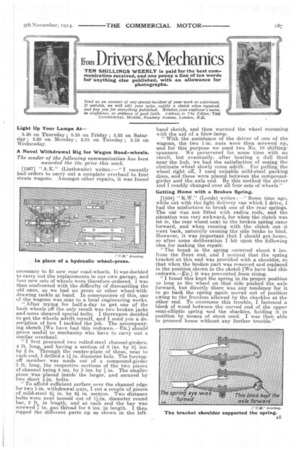limn Drivers kMechanics Light Up Your Lamps At 5.26 on
Page 19

If you've noticed an error in this article please click here to report it so we can fix it.
Thursday ; 5.25 on Friday ; 5.23 on Saturday; 5.20 on Monday ; 5.18 on Tuesday ; 5.16 on Wednesday.
A Novel Withdrawal Rig for Wagon Road-wheels.
The sender of the following communication has been awarded the Ws. prize this week.
[1567] " A.K." (Linthwaite) writes —"I recently had orders to carry out a complete overhaul to four steam wagons. Amongst other repairs, it was found
necessary to fit new rear road-wheels. It was decided to carry out the replacements in our own garage, and four new sets of wheels were therefore ordered. I was then confronted with the difficulty of dismantling the old ones, as we had no press or other wheel-withdrawing tackle at hand. In consequence of this, one of the wagons was sent to a local engineering works.
"After trying for half-a-day to get one of the back wheels pff the only result was two broken jacks and some sheared special bolts. I thereupon decided to get the wheels adrift myself, and I send you a description of how I tackled the job. The accompanying sketch [We have had this redrawn.—En.] should prove useful to mechanics who have to carry out a similar overhaul.
"I first procured two rolled-steel channel-girders, 4 ft. long, and having a section. of 8 ins. by 31 ins. by I in. Through the centre-plate of these, near to each end, I drilled a i in. diameter hole. The forcingoff member was made out of a compound-girder 3 ft. long, the respective sections of the two pieces of channel being 8 ins. by 3 ins. by 1 in. The smaller piece was placed inside the larger, and secured by two short 1-in. bolts. 'To afford sufficient surface over the channel edge for two 1-in. withdrawal nuts, I cut a couple of pieces of mild-steel 21in. by 2i in. section. Two distance bolts were next turned out of 11--in, diameter round bar, 2 ft. in length, and at each end the bar was screwed i in. gas thread for 6 ins, in length. I then rigged the different parts up as shown in the left
hand sketch, and then warmed the wheel mounting with the aid of a blow-lamp.
"With the assistance of the driver of one of the wagons, the two 1-in, nuts were then screwed up, and for this purpose we used two No, 10 shiftingspanners. We persevered for some time with no result, but eventually, after hearing a dull thud near the hub, we had the satisfaction of seeing the obstinate wheel slowly come adrift. For pulling the wheel right off, I used suitable mild-steel packing disc,s, and these were placed between the compoundgirder and the axle end. By this method the driver and I readily changed over all four sets of wheels."
Getting Home with a Broken Spring.
[1568] "R.W." (Leeds) writes ;—" Some time ago, while out with the light delivery van which I drive, I had the misfortune to break one of the rear springs. The car was not fitted with radius rods, and the situation was very awkward, for when the clutch was let in, the rear wheel next to the broken spring came forward, and when running with the clutch out it went back, naturally causing the side brake to bind. However, it was important that I should get .home, so after some deliberation I hit upon the following idea for making the repair.
"The break in the spring occurred about 6 ins. from the front end, and I noticed that the spring bracket at this end was provided with a shoulder, so that when the broken part was removed and replaced in the position shown in the sketch [We have had this redrawn.—En.] it was prevented from rising.
"I found this kept the spring in its proper position so long as the wheel on that side pushed the axle forward, but directly there was any tendency for it to go back the spring again moved out of position owing to the freedom allowed by the shackles at the other end. To ,overcome this trouble, I fastened a block of wood between the curved end of the upper semi-elliptic spring and the shackles, holding it in position by means of stout cord. I was then able to proceed home without any further trouble."




















